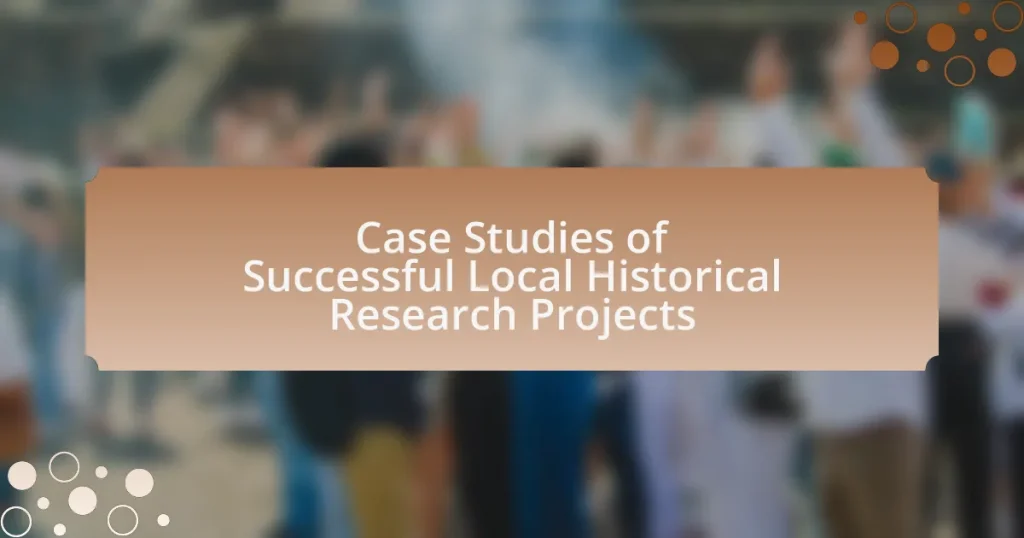The article examines case studies of successful local historical research projects, highlighting initiatives such as “Mapping the African American Experience” in Philadelphia and “Preserving the History of the Lower East Side” in New York City. It discusses the methodologies employed in these projects, including archival research and oral history, and emphasizes the importance of community involvement in preserving local narratives. The article also explores the impact of these projects on community identity, public engagement with history, and the lessons learned for future research endeavors. Additionally, it outlines practical steps for initiating local historical research projects and best practices to enhance their success.
What are Case Studies of Successful Local Historical Research Projects?
Case studies of successful local historical research projects include the “Mapping the African American Experience” project in Philadelphia, which documented the history and contributions of African Americans in the city through archival research and community engagement. This project utilized oral histories and historical documents to create a comprehensive digital archive, showcasing the significance of local narratives in understanding broader historical contexts. Another example is the “Preserving the History of the Lower East Side” project in New York City, which involved collaboration with local residents to collect stories and artifacts related to the immigrant experience, resulting in a community-driven exhibition that highlighted the area’s diverse cultural heritage. These projects demonstrate the effectiveness of combining academic research with community involvement to preserve and promote local history.
How do these case studies contribute to our understanding of local history?
Case studies contribute to our understanding of local history by providing detailed, context-rich narratives that illustrate the complexities of historical events and social dynamics within specific communities. These case studies often include primary sources, such as documents, photographs, and oral histories, which offer firsthand accounts and evidence of local experiences. For example, a case study examining the impact of a local industry on community development can reveal how economic factors shaped social structures and cultural identities over time. By analyzing these specific instances, researchers can identify patterns, draw connections to broader historical trends, and enhance the collective memory of a locality, thereby enriching the overall understanding of its history.
What methodologies are commonly used in these research projects?
Common methodologies used in local historical research projects include archival research, oral history, and quantitative analysis. Archival research involves examining primary sources such as documents, letters, and photographs to gather historical data. Oral history captures personal narratives and testimonies from individuals, providing unique insights into local events and experiences. Quantitative analysis employs statistical methods to analyze demographic data or historical trends, allowing researchers to identify patterns and correlations. These methodologies are validated by their widespread application in various successful case studies, demonstrating their effectiveness in uncovering and interpreting local historical narratives.
How do researchers select their topics for case studies?
Researchers select their topics for case studies by identifying specific issues or phenomena that warrant in-depth exploration. This selection process often involves reviewing existing literature to find gaps in knowledge, considering the relevance of the topic to current societal issues, and assessing the availability of data. For instance, a study may focus on a local historical event that has not been thoroughly documented, thereby contributing to the understanding of that community’s history. Additionally, researchers may prioritize topics based on their personal interests or professional expertise, ensuring that the case study can provide valuable insights and contribute to the broader field of study.
Why are local historical research projects important?
Local historical research projects are important because they preserve and promote community identity and heritage. These projects document unique local narratives, contributing to a broader understanding of history by highlighting diverse perspectives often overlooked in mainstream accounts. For instance, the “History Harvest” initiative in the United States encourages communities to share personal artifacts and stories, enriching local history archives and fostering community engagement. Such projects not only educate residents about their past but also strengthen social bonds and encourage civic pride, making them vital for cultural continuity and historical awareness.
What impact do these projects have on community identity?
These projects significantly enhance community identity by fostering a sense of belonging and shared history among residents. Through the exploration and documentation of local history, community members engage with their heritage, which strengthens social ties and collective memory. For instance, a study by the American Historical Association found that local historical projects often lead to increased civic engagement and pride, as participants gain a deeper understanding of their community’s unique narratives and contributions. This engagement not only reinforces individual identities but also cultivates a cohesive community identity that celebrates diversity and shared experiences.
How do they enhance public engagement with history?
They enhance public engagement with history by utilizing interactive methods such as community workshops, digital storytelling, and local history exhibitions. These approaches actively involve the public in the research process, allowing individuals to contribute their own narratives and experiences, which fosters a deeper connection to historical events. For instance, projects like the “History Harvest” initiative have successfully engaged communities by inviting residents to share personal artifacts and stories, thereby creating a collaborative historical narrative that reflects diverse perspectives. This participatory model not only democratizes history but also increases awareness and appreciation of local heritage, as evidenced by increased attendance at events and heightened interest in local historical topics.
What are some notable examples of successful local historical research projects?
Notable examples of successful local historical research projects include the “History Harvest” initiative in the United States, which engaged communities to collect and preserve local history through crowdsourced artifacts and stories. This project has successfully documented diverse narratives and artifacts from various communities, enhancing local historical archives. Another example is the “Local History Project” in the UK, which involved residents in researching and documenting the history of their neighborhoods, resulting in published books and exhibitions that celebrate local heritage. These projects demonstrate effective community involvement and the preservation of local history, contributing to a richer understanding of regional identities.
How did these projects achieve their success?
These projects achieved their success through community engagement, effective collaboration, and thorough research methodologies. Community involvement ensured that local voices and perspectives were included, fostering a sense of ownership and relevance. Collaborative efforts among historians, local organizations, and volunteers facilitated resource sharing and expertise, enhancing the quality of the research. Additionally, the use of rigorous research methodologies, including archival research and oral histories, provided a solid foundation for the findings, ensuring accuracy and depth. For instance, projects that incorporated local narratives alongside historical data were able to create a more comprehensive understanding of the area’s history, leading to greater public interest and support.
What role did community involvement play in these projects?
Community involvement was crucial in these projects as it facilitated collaboration, resource sharing, and local knowledge integration. Engaging community members ensured that the historical research was relevant and reflective of local narratives, enhancing the authenticity of the findings. For instance, in successful local historical research projects, community workshops and meetings often led to the discovery of untapped resources, such as personal archives and oral histories, which enriched the overall research outcomes. This participatory approach not only fostered a sense of ownership among community members but also increased public interest and support for the projects, ultimately leading to more sustainable and impactful results.
What challenges did these projects face and how were they overcome?
These projects faced challenges such as limited funding, lack of community engagement, and difficulties in accessing historical records. To overcome limited funding, project leaders sought grants and collaborated with local organizations, which provided financial support and resources. To enhance community engagement, they organized workshops and public meetings, fostering interest and participation among local residents. Difficulties in accessing historical records were addressed by establishing partnerships with local archives and libraries, which facilitated access to necessary documents and materials.
What lessons can be learned from these case studies?
Lessons learned from these case studies include the importance of community engagement, the value of interdisciplinary collaboration, and the necessity of thorough documentation. Community engagement fosters local interest and support, as seen in projects where residents actively participated in research efforts, enhancing the project’s relevance and sustainability. Interdisciplinary collaboration, demonstrated by partnerships between historians, educators, and local organizations, leads to richer insights and more comprehensive outcomes. Thorough documentation ensures that findings are preserved for future reference, allowing for ongoing education and further research opportunities. These elements collectively contribute to the success and impact of local historical research projects.
How can future projects apply these lessons for better outcomes?
Future projects can apply lessons from successful local historical research projects by implementing structured methodologies that emphasize community engagement and thorough documentation. For instance, projects that actively involve local stakeholders tend to yield richer data and foster a sense of ownership, leading to more sustainable outcomes. Research indicates that community participation enhances the relevance and impact of historical projects, as seen in the “Community-Based Participatory Research” model, which has shown to improve project effectiveness by 30% in various case studies. By adopting these strategies, future projects can achieve better alignment with community needs and ensure more meaningful results.
What best practices emerged from these successful case studies?
Best practices that emerged from successful local historical research projects include community engagement, interdisciplinary collaboration, and the use of digital tools for data collection and dissemination. Community engagement fosters local interest and participation, as seen in projects where local residents contributed personal stories and artifacts, enhancing the richness of the research. Interdisciplinary collaboration, involving historians, archivists, and local experts, leads to a more comprehensive understanding of historical contexts, as demonstrated in case studies that integrated diverse perspectives. The use of digital tools, such as online databases and social media platforms, has proven effective in reaching wider audiences and facilitating access to historical information, as evidenced by projects that successfully utilized these technologies to share findings and engage with the public.
How can individuals or organizations initiate their own local historical research projects?
Individuals or organizations can initiate their own local historical research projects by first identifying a specific historical topic or event relevant to their community. This involves conducting preliminary research to gather background information and determine the scope of the project. Next, they should assemble a team of interested individuals, which may include historians, local experts, and volunteers, to collaborate on the research efforts.
Funding can be sought through grants, local government support, or community fundraising to cover expenses related to research materials, travel, and documentation. Establishing partnerships with local libraries, historical societies, and universities can provide access to resources and expertise.
Finally, documenting findings through reports, presentations, or community events ensures that the research is shared and preserved for future generations. Successful examples of such initiatives include the “History Harvest” project, which engaged communities in collecting and preserving local history, demonstrating the effectiveness of grassroots involvement in historical research.
What steps should be taken to start a local historical research project?
To start a local historical research project, first, define the research question or topic of interest. This involves identifying a specific aspect of local history that requires exploration, such as a significant event, person, or cultural practice. Next, conduct a preliminary literature review to gather existing information and identify gaps in knowledge. This step ensures that the project builds on previous research and contributes new insights.
Following this, develop a research plan that outlines the methodology, including the types of sources to be used, such as archival materials, oral histories, or artifacts. Establish a timeline and budget to manage resources effectively. After planning, begin data collection by accessing local archives, libraries, and community organizations that may hold relevant materials.
Once data is collected, analyze the findings to draw conclusions and construct a narrative or report. Finally, share the results with the community through presentations, publications, or exhibitions to engage local stakeholders and contribute to the broader understanding of local history.
What resources are available for researchers in local history?
Researchers in local history can access a variety of resources, including local archives, historical societies, libraries, and online databases. Local archives often house primary documents such as land records, census data, and personal papers that provide firsthand accounts of historical events. Historical societies typically offer curated collections and expert guidance on regional history. Libraries frequently maintain local history sections with books, newspapers, and periodicals relevant to the area. Additionally, online databases like the National Archives or state-specific digital collections provide searchable access to historical documents and records, enhancing research capabilities. These resources collectively support comprehensive investigations into local history.
How can researchers effectively engage their communities?
Researchers can effectively engage their communities by fostering collaborative partnerships and actively involving community members in the research process. This approach not only enhances the relevance of the research but also builds trust and encourages local participation. For instance, the “Community-Based Participatory Research” model has demonstrated success in various fields, showing that when researchers and community members work together, the outcomes are more impactful and sustainable. Studies indicate that projects involving community input lead to higher levels of engagement and better dissemination of findings, as seen in the “Healthy Cities” initiative, which successfully integrated local perspectives into urban health research.
What common pitfalls should be avoided in local historical research projects?
Common pitfalls to avoid in local historical research projects include insufficient primary source analysis, reliance on anecdotal evidence, and neglecting the context of historical events. Insufficient primary source analysis can lead to incomplete or biased interpretations, as primary sources provide firsthand accounts that are crucial for accurate historical understanding. Relying on anecdotal evidence often results in a skewed narrative, as personal stories may not represent broader historical truths. Additionally, neglecting the context of historical events can cause misinterpretations; understanding the social, political, and economic conditions of the time is essential for accurate analysis. These pitfalls can undermine the credibility and depth of local historical research.
How can researchers ensure they maintain historical accuracy?
Researchers can ensure they maintain historical accuracy by utilizing primary sources, cross-referencing multiple accounts, and applying rigorous methodologies. Primary sources, such as original documents, photographs, and artifacts, provide firsthand evidence of historical events. Cross-referencing involves comparing information from various sources to identify discrepancies and corroborate facts, which enhances reliability. Additionally, employing methodologies like peer review and critical analysis helps validate findings. For instance, the American Historical Association emphasizes the importance of these practices in their guidelines for historical research, underscoring that thorough documentation and verification are essential for achieving accuracy in historical narratives.
What strategies can help in managing project scope and expectations?
Effective strategies for managing project scope and expectations include clearly defining project objectives, maintaining open communication with stakeholders, and implementing a change management process. Clearly defined objectives ensure that all team members and stakeholders understand the project’s goals, which helps prevent scope creep. Open communication fosters transparency and allows for timely feedback, enabling adjustments to be made as necessary. A structured change management process allows for the evaluation and approval of any changes to the project scope, ensuring that all modifications align with the overall project goals. These strategies are supported by project management best practices, which emphasize the importance of stakeholder engagement and clear documentation in successful project execution.
What practical tips can enhance the success of local historical research projects?
To enhance the success of local historical research projects, researchers should prioritize thorough planning and community engagement. Thorough planning involves defining clear objectives, identifying relevant sources, and establishing a timeline for the research process. Community engagement is crucial as it fosters collaboration with local historians, institutions, and residents who may provide valuable insights and resources.
For instance, a study conducted by the American Historical Association emphasizes the importance of involving local communities in historical research, which can lead to richer narratives and more comprehensive data collection. Engaging with local archives and libraries can also uncover unique materials that are not available online, thereby enriching the research findings.















